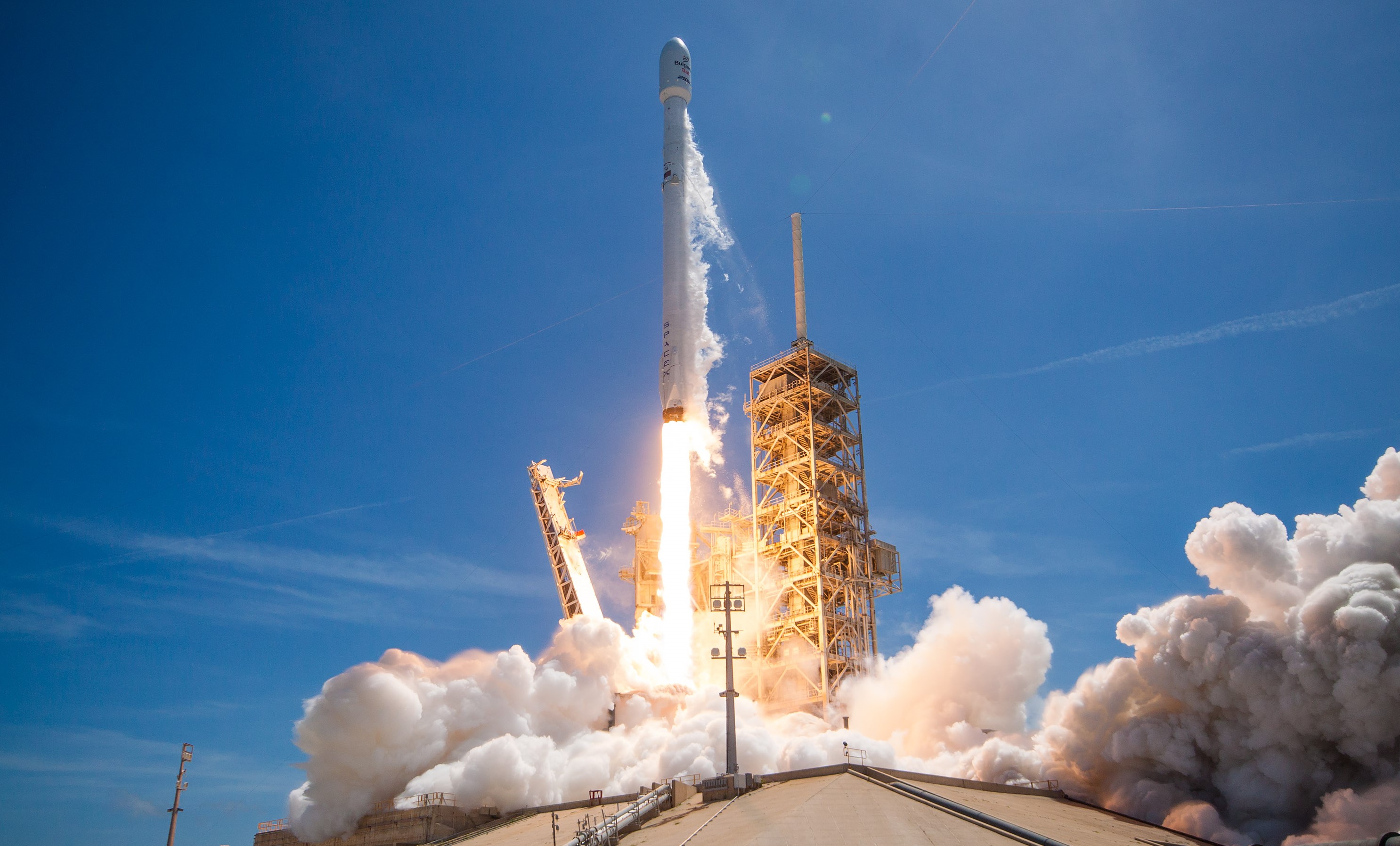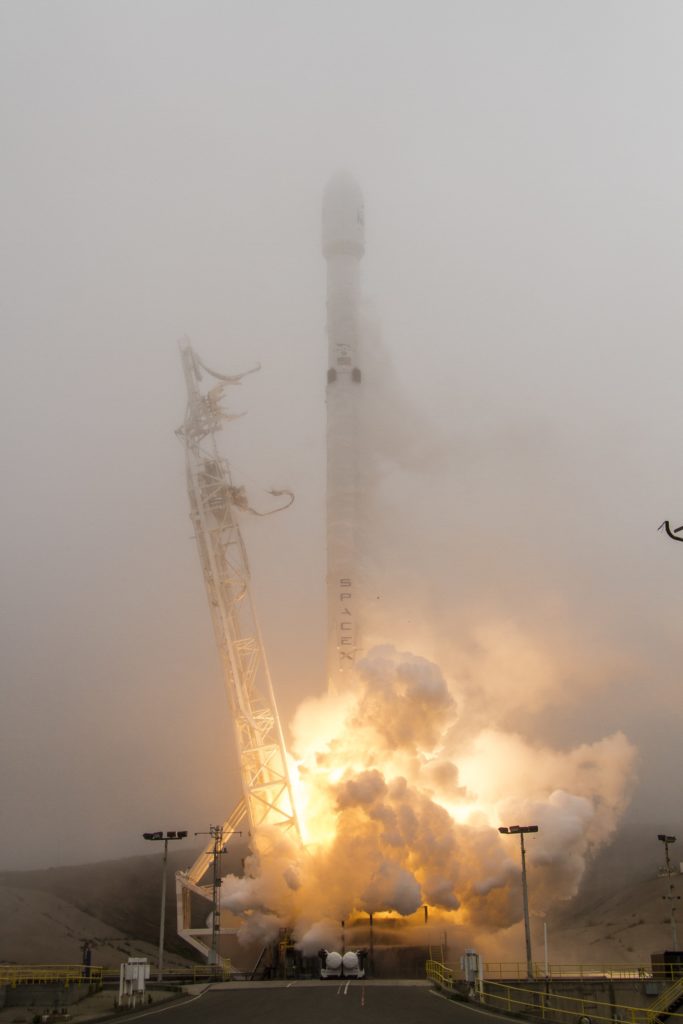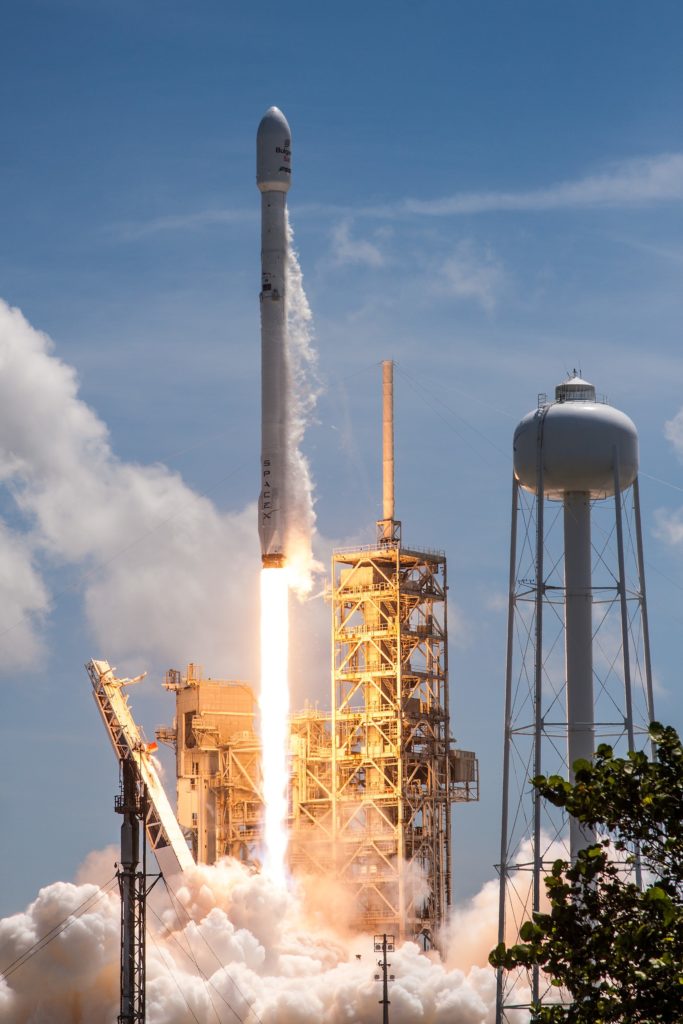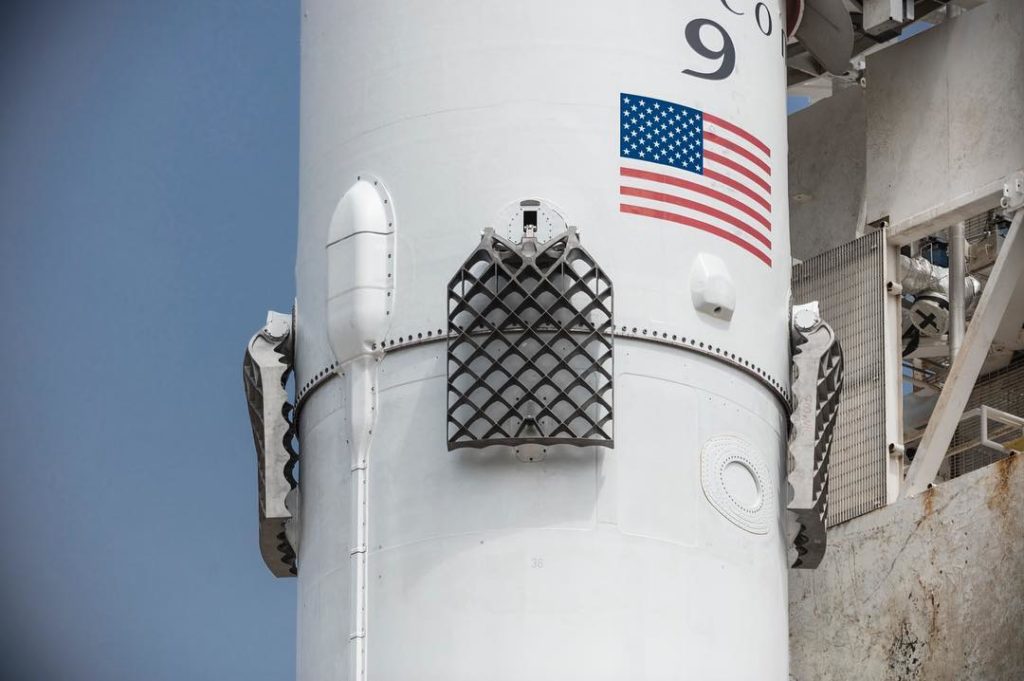

News
SpaceX on track for biweekly launch cadence in the remainder of year
Weekly rapid reuse launches expected by 2019

The foggy, atmospheric launch of Iridium-2 just yesterday. (SpaceX)
Following a weekend of extraordinary accomplishments, seeing SpaceX flawlessly execute two missions – one with a reused first stage – in just over 48 hours of each other, the company has capitalized on a uniquely successful weekend and year and offered information about their future plans.
The launch of BulgariaSat-1 and Iridium-2 on Friday and Sunday respectively marked the eight and ninth launches of 2017 for SpaceX, and officials at the company are reportedly expecting to launch approximately 24 missions this year, meaning 15 more to come over the next 6 months. Given the recent demonstration of 48 hour launch cadence and a more regular schedule of biweekly launches in the past few months, an expectation of 15 more launches for 2017 lines up perfectly with a cadence of two launches a month from LC-39A Cape Canaveral and three Iridium launches from Vandenberg, which happens to be exactly what is currently manifested.
Originally manifested for up to 27 launches this year, successfully launching 24 missions, one of which might be the inaugural flight of Falcon Heavy, would be extraordinarily hard to ignore in an industry that has compared the launch industry to manufacturing beverage containers and argued that reuse is only sustainable with more than 20 launches a year on a company’s manifest.

BulgariaSat-1 was successfully launched 48 hours before Iridium-2, and marked the second successful, commercial reuse of an orbital rocket. (SpaceX)
SpaceX is now likely to undertake 24 launches this year, but the company also revealed this weekend that it intends to achieve a regular weekly launch cadence (52 launches per year) as soon as 2019. In a recent article, I speculated that we might begin to see regular weekly launches once both LC-39A and LC-40 were active, and that appears to be nearly correct. If SpaceX is to regularly conduct weekly launches by 2019, it is bound to begin shrinking its two week cadence as soon as is safe and possible. This will likely occur once Falcon Heavy has successfully flown several times from LC-39A, thus freeing SpaceX to deem the vehicle operational and less at risk of destroying one of their two Eastern pads.
There is also a tentative understanding that SpaceX is striving to construct and activate their planned Boca Chica, Texas launch complex by 2019. The successful reactivation of LC-40 and subsequent modification of LC-39A for Falcon Heavy will leave the brunt of SpaceX’s launch complex maintenance and construction teams free to focus entirely on the Texas facility sometime late this year or early next year, meaning that Boca Chica pad activation could certainly occur as early as 2019. This would leave the company with two fully operational all-purpose launch pads dedicated to Falcon 9 launches if they choose to retain LC-39A solely for Falcon Heavy and Commercial Crew launches, allowing them to reach weekly cadences even before the launches of Falcon Heavy, Commercial Crew contracts, and Vandenberg launches are accounted for.
One crucial factor playing into SpaceX’s ability to launch 52 times in a year is of course reusability, as it is hard to imagine SpaceX more than doubling their Falcon manufacturing capabilities in under a year and a half. Likely no coincidence, SpaceX simultaneously offered information to insurance underwriters about the increasing speed of their ability to launch, recover, and reuse first stages. More specifically, a spokesman of the company stated that the reuse of BulgariaSat-1’s Falcon 9 1029 took considerably less than half as long as the inaugural reuse of the stage that launched SES-10 earlier this year, implying that refurbishment and quality assurance checks for 1029 took something like four or five months total.
With SpaceX having debuted new titanium grid fins intended to speed up reuse on the Sunday launch of Iridium-2, the company is well on its way to transferring over to Block 4 (upgraded engine performance) and possibly Block 5 of Falcon 9 later this. Block 5 is expected to introduced major changes meant to replace aspects of the current Falcon 9 that require major refurbishment after recovery. Musk detailed these changes several months ago in a Reddit AMA (Ask Me Anything), mentioning that reusable heat shielding around the engines, improved landing legs, and titanium grid fins were the main aspects of a Block 5 of Falcon 9 meant to offer rapid reuse without refurbishment. In June 22nd interview on the Space Show, Gwynne Shotwell reiterated that this “final” version of Falcon 9 is expected to be able to launch, land, and relaunch with barely more than a thorough once-over, and ought to be capable of flying a dozen missions at least.

Falcon 9’s fancy new titanium grid fins. (SpaceX/Instagram)
This final piece of the puzzle of weekly cadence fits in quite nicely. With a possible introduction date for Block 5 of late 2017 or early 2018, SpaceX will likely end production of Block 3 by the end of this year and transfer over entirely to the easily reusable Block 5. Assuming a continuing a trend of increasingly reuse-friendly customers, Hawthorne production capacity of approximately 20 Falcon 9s per year, and a plausibly significant reduction in launch costs due to more rapid and complete reuse, SpaceX could find themselves at the start of 2019 with a dozen or more launch vehicles that are each capable of conducting upwards of 10-12 highly affordable launches each.
Let there be no doubt: these are incredibly optimistic and difficult goals for the company to achieve on the timescale they have provided. However, given the number of beneficial changes likely to soon be made to both the launch vehicles and SpaceX’s manufacturing, launch, and refurbishment facilities in the next 6-12 months, those goals are realistically achievable, albeit with some likely delays. Regardless, things are beginning to get rather intense for SpaceX and for the launch industry in general.
Keep your eyes peeled for upcoming Teslarati coverage of SpaceX’s next July 4th launch and its static fire that is scheduled for as soon as this Thursday.
News
Tesla begins Robotaxi certification push in Arizona: report
Tesla seems serious about expanding its Robotaxi service to several states in the coming months.

Tesla has initiated discussions with Arizona transportation regulators to certify its driverless Robotaxi service in the state, as per a recent report from Bloomberg News. The move follows Tesla’s launch of its Robotaxi pilot program in Austin, Texas, as well as CEO Elon Musk’s recent comments about the service’s expansion in the Bay Area.
The Arizona Department of Transportation confirmed to Bloomberg that Tesla has reached out to begin the certification process for autonomous ride-sharing operations in the state. While details remain limited, the outreach suggests that Tesla is serious about expanding its driverless Robotaxi service to several territories in the coming months.
The Arizona development comes as Tesla prepares to expand its service area in Austin this weekend, as per CEO Elon Musk in a post on X. Musk also stated that Tesla is targeting the San Francisco Bay Area as its next major market, with a potential launch “in a month or two,” pending regulatory approvals.
Tesla first launched its autonomous ride-hailing program on June 22 in Austin with a small fleet of Model Y vehicles, accompanied by a Tesla employee in the passenger seat to monitor safety. While still classified as a test, Musk has said the program will expand to about 1,000 vehicles in the coming months. Tesla will later upgrade its Robotaxi fleet with the Cyercab, a two-seater that is designed without a steering wheel.
Sightings of Cybercab castings around the Giga Texas complex suggests that Tesla may be ramping the initial trial production of the self-driving two-seater. Tesla, for its part, has noted in the past that volume production of the Cybercab is expected to start sometime next year.
In California, Tesla has already applied for a transportation charter-party carrier permit from the state’s Public Utilities Commission. The company is reportedly taking a phased approach to operating in California, with the Robotaxi service starting with pre-arranged rides for employees in vehicles with safety drivers.
News
Tesla sets November 6 date for 2025 Annual Shareholder Meeting
The automaker announced the date on Thursday in a Form 8-K.

Tesla has scheduled its 2025 annual shareholder meeting for November 6, addressing investor concerns that the company was nearing a legal deadline to hold the event.
The automaker announced the date on Thursday in a Form 8-K submitted to the United States Securities and Exchange Commission (SEC). The company also listed a new proposal submission deadline of July 31 for items to be included in the proxy statement.
Tesla’s announcement followed calls from a group of 27 shareholders, including the leaders of large public pension funds, which urged Tesla’s board to formally set the meeting date, as noted in a report from The Wall Street Journal.
The group noted that under Texas law, where Tesla is now incorporated, companies must hold annual meetings within 13 months of the last one if requested by shareholders. Tesla’s previous annual shareholder meeting was held on June 13, 2024, which placed the July 13 deadline in focus.
Tesla originally stated in its 2024 annual report that it would file its proxy statement by the end of April. However, an amended filing on April 30 indicated that the Board of Directors had not yet finalized a meeting date, at least at the time.
The April filing also confirmed that Tesla’s board had formed a special committee to evaluate certain matters related to CEO Elon Musk’s compensation plan. Musk’s CEO performance award remains at the center of a lengthy legal dispute in Delaware, Tesla’s former state of incorporation.
Due to the aftermath of Musk’s legal dispute about his compensation plan in Delaware, he has not been paid for his work at Tesla for several years. Musk, for his part, has noted that he is more concerned about his voting stake in Tesla than his actual salary.
At last year’s annual meeting, TSLA shareholders voted to reapprove Elon Musk’s compensation plan and ratified Tesla’s decision to relocate its legal domicile from Delaware to Texas.
Elon Musk
Grok coming to Tesla vehicles next week “at the latest:” Elon Musk
Grok’s rollout to Tesla vehicles is expected to begin next week at the latest.

Elon Musk announced on Thursday that Grok, the large language model developed by his startup xAI, will soon be available in Tesla vehicles. Grok’s rollout to Tesla vehicles is expected to begin next week at the latest, further deepening the ties between the two Elon Musk-led companies.
Tesla–xAI synergy
Musk confirmed the news on X shortly after livestreaming the release of Grok 4, xAI’s latest large language model. “Grok is coming to Tesla vehicles very soon. Next week at the latest,” Musk wrote in a post on social media platform X.
During the livestream, Musk and several members of the xAI team highlighted several upgrades to Grok 4’s voice capabilities and performance metrics, positioning the LLM as competitive with top-tier models from OpenAI and Google.
The in-vehicle integration of Grok marks a new chapter in Tesla’s AI development. While Tesla has long relied on in-house systems for autonomous driving and energy optimization, Grok’s integration would introduce conversational AI directly into its vehicles’ user experience. This integration could potentially improve customer interaction inside Tesla vehicles.
xAI and Tesla’s collaborative footprint
Grok’s upcoming rollout to Tesla vehicles adds to a growing business relationship between Tesla and xAI. Earlier this year, Tesla disclosed that it generated $198.3 million in revenue from commercial, consulting, and support agreements with xAI, as noted in a report from Bloomberg News. A large portion of that amount, however, came from the sale of Megapack energy storage systems to the artificial intelligence startup.
In July 2023, Musk polled X users about whether Tesla should invest $5 billion in xAI. While no formal investment has been made so far, 68% of poll participants voted yes, and Musk has since stated that the idea would be discussed with Tesla’s board.
-

 Elon Musk1 week ago
Elon Musk1 week agoTesla investors will be shocked by Jim Cramer’s latest assessment
-

 Elon Musk3 days ago
Elon Musk3 days agoElon Musk confirms Grok 4 launch on July 9 with livestream event
-

 Elon Musk16 hours ago
Elon Musk16 hours agoxAI launches Grok 4 with new $300/month SuperGrok Heavy subscription
-

 News7 days ago
News7 days agoTesla Model 3 ranks as the safest new car in Europe for 2025, per Euro NCAP tests
-

 Elon Musk2 weeks ago
Elon Musk2 weeks agoA Tesla just delivered itself to a customer autonomously, Elon Musk confirms
-

 Elon Musk1 week ago
Elon Musk1 week agoxAI’s Memphis data center receives air permit despite community criticism
-

 Elon Musk2 weeks ago
Elon Musk2 weeks agoTesla’s Omead Afshar, known as Elon Musk’s right-hand man, leaves company: reports
-

 News2 weeks ago
News2 weeks agoXiaomi CEO congratulates Tesla on first FSD delivery: “We have to continue learning!”













